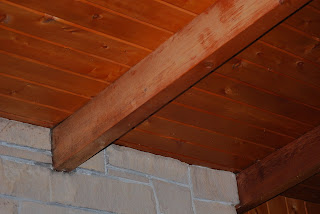Our house is old. Not ancient, nor historic - just comfortably lived in since the 1950’s when it was built. Although it’s had several additions over the years, the original part of the house has natural wood ceilings with thick, old, open beams and wide planks running across those. In the evenings the house plays its own symphony - moaning, groaning, and loudly cracking as the old beams contract with the cooling air. Morning sounds the same, as the wood slowly expands with the warmth of day. We’ve grown accustomed to the sounds, but visitors are often startled by the loud cracks.
Since the beginning, wood has been valued for making tools, houses, and myriad other things of use to mankind. Native Americans were the first to cut down and use trees in our area. Drift logs landing on the beach were welcomed and used, but they could not supply all the needs of a village. Thousands of years before the first non-natives arrived, they learned to fell the giant trees, using a variety of tools and methods.
Early explorers were impressed with the huge trees, seeking them from the very beginning for use on their sailing ships. The tall, straight firs and spruces were especially desired for ship spars - those tall, wooden poles which held their sails and rigging. They readily traded with the native people, gleaning their knowledge of the great trees and enlisting their help to acquire them. Although newcomers developed their own methods of logging, there is no doubt they observed and learned much from the Native’s methods.
 There were no roads back then, only the water and a few native or animal trails, so people usually traveled by boat. In the 1850s, the first sawmills here were supplied with logs from trees growing near the water. Loggers began at the water’s edge and cut their way inland. Getting logs from forest to mill was a challenge and methods developed and changed as necessary to supply the growing need. Before the railroad arrived, loggers used horse and ox teams to drag logs over skid roads down to the water, where the logs were formed into huge rafts and floated to the mills. By 1881, a Seattle paper reported that the best timber had been cut from the shore of Hood Canal one and a half miles back for its entire length. The same was true for most readily accessible areas around the Puget Sound.
There were no roads back then, only the water and a few native or animal trails, so people usually traveled by boat. In the 1850s, the first sawmills here were supplied with logs from trees growing near the water. Loggers began at the water’s edge and cut their way inland. Getting logs from forest to mill was a challenge and methods developed and changed as necessary to supply the growing need. Before the railroad arrived, loggers used horse and ox teams to drag logs over skid roads down to the water, where the logs were formed into huge rafts and floated to the mills. By 1881, a Seattle paper reported that the best timber had been cut from the shore of Hood Canal one and a half miles back for its entire length. The same was true for most readily accessible areas around the Puget Sound.
Human need is nothing new. In 950 BC, mighty King Solomon set out to build his massive temple, followed by an impressive palace. To complete the projects, he needed quality materials and highly-skilled craftsmen. Being practical, as well as wise, he established a working relationship with Hiram, king of Tyre to acquire all the timber he needed. He completed both in 20 years.
Apparently, “bigger is better” is not a new concept, either. Exactly how much house, furniture, and toys are enough? Enveloped and protected by the native woods in our home, I wonder - at what point does “need” become “greed”?
So Hiram sent word to Solomon:
"I have received the message you sent me and will do all you want in providing the cedar and pine logs. My men will haul them down from Lebanon to the sea, and I will float them in rafts by sea to the place you specify. There I will separate them and you can take them away. And you are to grant my wish by providing food for my royal household."
1 Kings 5:8-9
By your messengers
you have heaped insults on the Lord.
And you have said,
"With my many chariots
I have ascended the heights of the mountains
the utmost heights of Lebanon.
I have cut down its tallest cedars,
the choicest of its pines.
I have reached its remotest parts,
the finest of its forests..."
2 Kings 19:23








This is an interesting juxtapositioning of cultures around a resource. Thanks.
ReplyDelete